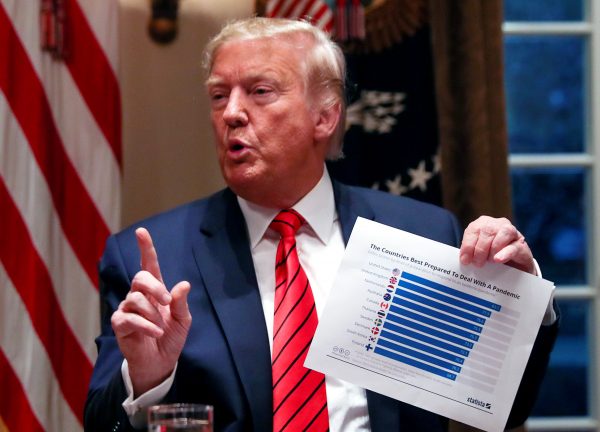Americans are losing jobs by the millions and dying by the tens of thousands.
Trump’s re-election campaign team wants to direct the blame for his country’s woes at China and cast him as a leader who saved the United States from even worse China-afflicted pain. Trump and his team have pushed a far-fetched story about the virus originating in a Wuhan lab. Administration officials including Vice President Mike Pence refer to the coronavirus as the ‘Chinese virus’. Trump has recently upped the ante, calling it the ‘Plague from China’ and saying that ‘100 trade deals wouldn’t make up for [the damage that has been done]’. The following day, on Fox News, Trump suggested that ‘we could cut off the whole relationship’.
Beijing has reacted with haste in seeking to control the coronavirus narrative. While admitting to early mistakes (blaming them on local officials), China’s leaders have sought to burnish their government’s credentials in leading an effective response to COVID-19, resulting in a lower infection and mortality rate than many richer countries, including the United States. When Trump lashed out at the World Health Organization (WHO) for incompetence and being ‘too close’ to China, subsequently halted US financial contributions, China stepped in with an additional US$30 million. Beijing has also provided aid to assist other countries, including the United States, respond to the virus.
Beijing has taken the opportunity to push its credentials as a responsible global citizen, in the process overreaching in its effort to control the narrative. It has mobilised ‘wolf warrior’ diplomats to pressure foreign governments into praising Beijing’s coronavirus response. China’s state media has attacked senior US officials by name, including US Secretary of State Mike Pompeo, and threatened sanctions against US politicians associated with anti-China litigation related to COVID-19. And, in one jaw-dropping moment, a spokesman for China’s Ministry of Foreign Affairs suggested that the virus originated not in China but was instead brought there by the US military.
As US–China relations deteriorate and the WHO becomes a football for the two countries’ rivalry, the potential for global coordination on COVID-19 is undermined. As Suisheng Zhao points out in the first of our feature essays this week, US–China rivalry prevented the United Nations Security Council (UNSC) from formulating a response. In the past, Zhao notes, the UNSC helped establish the Global Fund for AIDS, Tuberculosis, and Malaria. It also passed a resolution in 2014 declaring the Ebola epidemic in West Africa a ‘threat to international peace and security’, leading to the creation of the UN Mission for Ebola Emergency Response — the first UN mission to address a public health crisis.
In another feature essay this week Jia Qingguo worries that the current diplomatic standoff between Beijing and Washington is likely to continue for the foreseeable future. He sees no end to Trump’s anti-China stance in the year of his re-election campaign (Trump boasted on Fox News he could save America US$500 billion by cutting off the relationship with China) and no way that Beijing will back down from its equally muscular response. Even intervention by the two great helmsmen seems unlikely. Trump spoke of his ‘very good relationship’ with Xi Jinping, but said ‘right now I just don’t want to speak to him’.
The extent of the economic fallout from COVID-19 and souring US–China relations is difficult to gauge. In the third of our feature essays this week, Justin Yifu Lin examines China’s options for responding to the economic challenges, optimistic that China can still achieve GDP growth of 3-4 per cent in 2020 despite IMF forecasts that global growth will change by a similar amount in the opposite direction. Lin observes that COVID-19 has imposed both demand and supply-side economic destruction. He advocates investment in infrastructure to create jobs, but also calls for support of household consumption in the form of vouchers and cash transfers to low-income households, similar to income support that some Western countries have introduced.
According to Lin, ‘the Chinese government should take advantage of its favourable fiscal and monetary policy space to stabilise the financial system, increase credit to help enterprises, invest in new infrastructure and provide necessary support for families adversely affected by the pandemic. These measures will help to expand domestic demand, maintain social stability and eliminate the bottleneck of future economic growth’. If China can get its policies right, and achieve a reasonable rate of growth, Lin thinks there’s a chance that, just like after 2008, ‘China will drive the world’s economic growth and recovery as it emerges from the coronavirus crisis’. Lin leaves offers hope that, even if 2020 remains annus horribilis, 2021 could bring some cheer.
Yet a V-shaped economic recovery, in China or globally, is a faint hope without the invigoration of international cooperation in beating or managing COVID-19 and economic recovery policy strategies. The challenge for the rest of the world is to catalyse that in the midst of US–Chinese bickering.
The EAF Editorial Board is located in the Crawford School of Public Policy, College of Asia and the Pacific, The Australian National University.
This article is part of an EAF special feature series on the novel coronavirus crisis and its impact.

